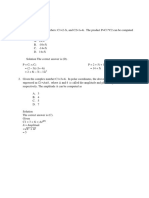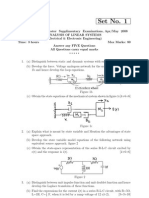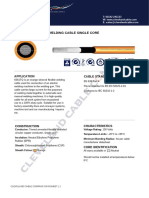Electrical Circuit Analysis-II
Uploaded by
meeravali_snElectrical Circuit Analysis-II
Uploaded by
meeravali_snJntuk online bits of Electrical Circuit Analysis-II for EEE
Q)Considering the following statements: For a reciprocal network (1) A=D (2) Z12 =Z21 (3) h12 = -h21 , of
these statements--> 2 and 3 are correct
Q)An ideal transformer cannot be described by--> z parameters
Q)When a number of 2-port networks are connected in cascade, the individual--> Chain matrices are
multiplied
Q)In a two port network, the condition for reciprocity in terms of h parameters--> h12= -h21
Q)A passive 2-port network is in a steady-state. Compared to its input, the steady state output can never
offer--> greater power
Q)A two port device is defined by the following pairs of the equations I1=2V1+V2 and I2=V1+V2 Its
impedance parameters(Z11,Z12,Z21,Z22)are given by--> (1,-1,-1,2)
Q)Condition for symmetry for Z parameters--> Z11=Z22
Q)Condition for reciprocity for Z parameters--> Z12 =Z21
Q)Condition for symmetry for ABCD parameters--> A=D
Q)Condition for Reciprocity for ABCD parameters--> AD-BC = 1
Q)Which of the following is correct in case of h parameters reciprocity--> h12 =-h21
Q)The impedance parameter Z11 in terms of ABCD parameters--> Z11 =
Q)A two-port network is described by V1=I1+2V2 and I2= -2I1+0.4V2 the impedance matrix is given by--
>
Q)What is the unit for parameter A--> no unit
Q)In h parameters, h12 is ________________--> open circuit reverse voltage gain
Q)The unit of Z-parameters is--> ohm
Q)If h11h22-h12h21=1,the network is called a ..network--> symmetrical
Q)The ABCD parameters is also known as --> Transmission line
Q)What is the unit for parameter C--> mho
Q)The h parameters are mostly used in--> transmission line
Q)A two-port network is symmetrical if--> h11h22-h12h21=1
Q)The Z parameters of the network shown is -->
Q)When a number of 2-port networks are connected in cascade, the individual--> Chain matrices are
multiplied
Q)For a given two-port , the short circuit parameters are Y11=12, Y12=Y21=4 and Y22=7 then the value Z22 for
this network is-->
Q)The value of Y22 in terms of Z parameters is.-->
Q)The ABCD matrix of the network shown in the figure is --
>
Q)The transfer matrix of the network given below is --
>
Q)If a two-port network is reciprocal, which of the following is not true--> h21=h12
Q)For the network shown below, the value of Z12 --> 5Ω
Q)The h parameters of the network shown below is -->
Q)The transfer function of a passive circuit has its poles and zeroes on--> Left and right halves respectively
of the s-plane
Q)The short circuit admittance matrix of a two-port network is --> Non reciprocal and
passive
Q)The response of a network is decided by the location of--> both zeroes and poles
Q)The zero of the function F(S)= --> -1
Q)The poles of the functionF(S)= --> -2,-3,-4
Q)When port 1 of a two port circuit is short circuited, I1=4 I2 and V2=0.25 I2. Which of the following is true--
> Y12=16
Q)What is the unit of parameter D--> no unit
Q)An impedance function whose real part varnishes at some real frequencyis called--> minimum resistance
function
Q)An RCdrivingpointfunction has zeroes at S=-2 &s =-5. Theadmissible poles forthe functions are--> S= -1,-
3
Q)Which oneof the followingis a +vereal function--> S(S2+4 ) / (S2+1 ) (S2+6 )
Q)For an RC driving point impedance function, the poles and zeroes--> should alternate only on the
negative real axis
Q)In an impedancefunction, apole at infinitytobe realized byusing--> an inductancein series
Q)As the poles of a network shift away from the axis, the response--> becomes less oscillating
Q)The pole-zero configuration of a network functionis shown. The magnitude of the transfer function
will --> Beindependent of frequency
Q)Consider the following statement 1. Transfer impedance is the reciprocal of transfer admittance. 2. One
can derive transfer impedance of a network if its driving point impedance and driving point admittance are
known. 3. Driving point impedance is the ratio of the Laplace transform of voltage and current time functions
at the input Of these statements--> 3 alone is correct
Q)In the case of RC driving point functions--> ZRC cannot have a pole at infinity
Q)The residues at the pole of Y(S) of an RC network are--> real and negative
Q)A Hurwitz polynomial has--> Zeroes only on the left half of the s-plane
Q)Of thefollowingdrivingpointimpedance, theone realized byan R-C networkis--> (s +1) (s+3) / s (s+2)
Q)The L-C driving point immittance function has poles and zeroes of Z(s) is on--> imaginary axis
Q)The L-C driving point immittance function has poles and zeroes of Y(s) is on--> imaginary axis
Q)Is function F(s)= --> positive real
Q)An impedance function whose real part vanishes at some real frequencyis called--> minimum
resistancefunction
Q)zero ofanetworkisthe critical frequencyatwhich network function becomes--> Zero
Q)The poles and zeroes of a positive real function are--> real or conjugate
Q)In an impedancefunction, apole at infinitytobe realized byusing--> an inductancein series
Q)The total number of elements in foster form of network realization is equal to--> the degree of highest
power of s in f(s)
Q)The expansion of function Z(s) looks like a ladder in.--> cauer form
Q)In cauer of function realization the utmost difference between the order of numerator and denominator-->
1
Q)In cauer of function realization if the order of the numerator is 2n then the order of the denominator is-->
2n-1
Q)In cauer forms 1.If degree of denominator is equal to that of the numerator then a constant can be obtained
from the function Z(s) 2. If degree of denominator is higher than that of the numerator ,no constant can be
obtained from the function Z(s) Of the above two statements--> both 1 and 2 are correct
Q)Cauer form 1 always eliminate a pole at--> infinity
Q)A function is said to be periodic if..--> x(t)=x(t+T)
Q) --> cauer 2 form
Q) --> Foster 1 form
Q)Is function positive real--> no
Q)Fourier series consists of--> DC and AC components
Q)Fourier series is applicable for--> periodic functions only
Q)A function is said to be even function if--> x(t)=x(-t)
Q)A function is said to be even function if--> x(-t)= -x(t)
Q)Sum of an even and odd function is--> neither even nor odd functions
Q)Fourier series spectra are--> discrete spectra
Q)Which among the following is Dirichlet condition-->
Q)What is the Fourier transform of step functionu(t)(only magnitude)--> Πδ(w) +
Q)The exponential representation of Fourier series is given by f(t)= -->
Q)What is the Fourier transform of impulse function--> 1
Q)Which among the following is the condition for half wave symmetry--> f(t
Q)Pick up the incorrect statement--> Two odd functions when multiplied together result in an odd
function.
Q)Fourier Transform is.--> Continuous spectra
Q) -->
Q)If f(t)=2u(t)-δ(t-1) then what is the value of F(j2)--> 0.426∟-12.30
Q)If f(t)=-f(-t) and f(t) satisfies the dirichlets conditions, then f(t) can be expanded in a Fourier series
containing--> only sine terms
Q)Fourier transform F(jw) of an arbitrary signal has the property--> F(jw)=F*(-jw)
Q)For the expansion of f(ax) in Fourier Series a0+a1 n 1 n --> bn=0 for all n
Q)A periodic function f(t) with time period T repeats itself after half time period --> even harmonic terms
only
Q)Which of the following statement is true for a delayed step function u(t-T)--> C .It does not have Fourier
series
Q)The Fourier series expansion of a periodic function with half wave symmetry contains--> only Odd
harmonics
Q)Half wave symmetry is also called as--> odd symmetry
Q)If Fourier Transform of f(t) =F(jw) then what is the Fourier transform [af(t)]--> aF(jw)
Q)The Fourier Transform of v(t) = --> V(f)= 0)+ δ(f-f0)]
Q)The Fourier Transform of v(t) = --> V(f)= 0)- δ(f-f0)]
Q)If Fourier Transform of f1(t) =F1(jw) and Fourier Transform of f2(t)= F2(jw) then Fourier Transform of [a
f1(t)+b f2(t)]=--> a F1(jw)+b F2(jw)
Q) If Fourier Transform of f(t) =F(jw) then what is the Fourier transform f(t-a)=--> F(jw)
Q)What is the Fourier transform of [u(t)-u(t-1)]-->
Q)The Fourier transform of a continuous time signal f(t) is given by F(w)= -->
Q)The Fourier Transform of v(t) = --> V(f)=2Π δ(f-f0)
Q)If Fourier transform of f(t) is F(jw) and Fourier transform of g(t) is G(jw) then Fourier transform
[f(t)+g(t)} is--> F(jw)+G(jw)
Q)What is the Fourier transform of A--> 2ΠAδ(w)
Q)What is the Fourier transform of -->
Q)The Fourier series of a function with half wave symmetry--> odd harmonic terms only
Q)If Fourier Transform of f(t) =F(jw) then what is the Fourier transform [f(at)]-->
You might also like
- Network Analysis and Synthesis Mid Term Exam May 2022 Second SemesterNo ratings yetNetwork Analysis and Synthesis Mid Term Exam May 2022 Second Semester3 pages
- Network Analysis MCQ For Apgenco&aptranco Preparation73% (22)Network Analysis MCQ For Apgenco&aptranco Preparation42 pages
- Ee 301 - Circuit Theory & Networks: Multiple Choice Type QuestionsNo ratings yetEe 301 - Circuit Theory & Networks: Multiple Choice Type Questions5 pages
- Btech Ece 3 Sem Circuit Theory and Networks 2010No ratings yetBtech Ece 3 Sem Circuit Theory and Networks 20108 pages
- EEC-304 Fundamentails of Network Analysis & SynthesisNo ratings yetEEC-304 Fundamentails of Network Analysis & Synthesis5 pages
- btech-all-3-sem-network-theory-bees2211-2020No ratings yetbtech-all-3-sem-network-theory-bees2211-20202 pages
- Btech All 3 Sem Network Theory Bees2211 2020No ratings yetBtech All 3 Sem Network Theory Bees2211 20202 pages
- Electrical Circuit Analysis - Ii Sept 2021No ratings yetElectrical Circuit Analysis - Ii Sept 20213 pages
- Network Analysis and Synthesis Worksheet and AssignmentsNo ratings yetNetwork Analysis and Synthesis Worksheet and Assignments5 pages
- Past Year Final Question (20122013 (2) ) SOLUTIONNo ratings yetPast Year Final Question (20122013 (2) ) SOLUTION9 pages
- Nodia and Company: Gate Solved Paper Electronics & Communication 2005No ratings yetNodia and Company: Gate Solved Paper Electronics & Communication 200539 pages
- EE-210. Signals and Systems Solutions of Homework 5 - Cyphynets PDFNo ratings yetEE-210. Signals and Systems Solutions of Homework 5 - Cyphynets PDF5 pages
- Subject: Network Analysis and Synthesis Sub Code: Max Marks: 70 Time: 180 MinNo ratings yetSubject: Network Analysis and Synthesis Sub Code: Max Marks: 70 Time: 180 Min3 pages
- Advanced Electric Drives: Analysis, Control, and Modeling Using MATLAB / SimulinkFrom EverandAdvanced Electric Drives: Analysis, Control, and Modeling Using MATLAB / SimulinkNo ratings yet
- Reference Guide To Useful Electronic Circuits And Circuit Design Techniques - Part 2From EverandReference Guide To Useful Electronic Circuits And Circuit Design Techniques - Part 2No ratings yet
- Electric Circuit Analysis - I Unit - 2: Power Factor & Its SignificanceNo ratings yetElectric Circuit Analysis - I Unit - 2: Power Factor & Its Significance3 pages
- Wiring Instructions For Marley 2500 Series Electric Baseboard Heaters XNo ratings yetWiring Instructions For Marley 2500 Series Electric Baseboard Heaters X7 pages
- 4.28 Analog Output Module SM 332 AO 4 (6ES7332-5HD01-0AB0) : X 12 BitsNo ratings yet4.28 Analog Output Module SM 332 AO 4 (6ES7332-5HD01-0AB0) : X 12 Bits4 pages
- Configuring The FlexTimer For Position and Speed Measurement With An EncoderNo ratings yetConfiguring The FlexTimer For Position and Speed Measurement With An Encoder10 pages
- Automotive: Selector Guide SG187 Q32014 Rev 56No ratings yetAutomotive: Selector Guide SG187 Q32014 Rev 5644 pages
- HD74LS76A: Dual J-K Flip-Flops (With Preset and Clear)No ratings yetHD74LS76A: Dual J-K Flip-Flops (With Preset and Clear)7 pages
- IO Modules AO-V-8 and AO-V-8-H Specification SheetNo ratings yetIO Modules AO-V-8 and AO-V-8-H Specification Sheet4 pages
- Parallel DC Circuits: Voltage in Parallel CircuitNo ratings yetParallel DC Circuits: Voltage in Parallel Circuit2 pages
- Bs638 (Part 4) 0361Tq Welding Cable Single CoreNo ratings yetBs638 (Part 4) 0361Tq Welding Cable Single Core2 pages
- ImprovedSuper RegenerativeReceiverTheoryNo ratings yetImprovedSuper RegenerativeReceiverTheory12 pages
- Network Analysis and Synthesis Mid Term Exam May 2022 Second SemesterNetwork Analysis and Synthesis Mid Term Exam May 2022 Second Semester
- Network Analysis MCQ For Apgenco&aptranco PreparationNetwork Analysis MCQ For Apgenco&aptranco Preparation
- Ee 301 - Circuit Theory & Networks: Multiple Choice Type QuestionsEe 301 - Circuit Theory & Networks: Multiple Choice Type Questions
- EEC-304 Fundamentails of Network Analysis & SynthesisEEC-304 Fundamentails of Network Analysis & Synthesis
- Network Analysis and Synthesis Worksheet and AssignmentsNetwork Analysis and Synthesis Worksheet and Assignments
- Nodia and Company: Gate Solved Paper Electronics & Communication 2005Nodia and Company: Gate Solved Paper Electronics & Communication 2005
- EE-210. Signals and Systems Solutions of Homework 5 - Cyphynets PDFEE-210. Signals and Systems Solutions of Homework 5 - Cyphynets PDF
- Subject: Network Analysis and Synthesis Sub Code: Max Marks: 70 Time: 180 MinSubject: Network Analysis and Synthesis Sub Code: Max Marks: 70 Time: 180 Min
- Advanced Electric Drives: Analysis, Control, and Modeling Using MATLAB / SimulinkFrom EverandAdvanced Electric Drives: Analysis, Control, and Modeling Using MATLAB / Simulink
- Reference Guide To Useful Electronic Circuits And Circuit Design Techniques - Part 2From EverandReference Guide To Useful Electronic Circuits And Circuit Design Techniques - Part 2
- Exercises in Electronics: Operational Amplifier CircuitsFrom EverandExercises in Electronics: Operational Amplifier Circuits
- Electric Circuit Analysis - I Unit - 2: Power Factor & Its SignificanceElectric Circuit Analysis - I Unit - 2: Power Factor & Its Significance
- Wiring Instructions For Marley 2500 Series Electric Baseboard Heaters XWiring Instructions For Marley 2500 Series Electric Baseboard Heaters X
- 4.28 Analog Output Module SM 332 AO 4 (6ES7332-5HD01-0AB0) : X 12 Bits4.28 Analog Output Module SM 332 AO 4 (6ES7332-5HD01-0AB0) : X 12 Bits
- Configuring The FlexTimer For Position and Speed Measurement With An EncoderConfiguring The FlexTimer For Position and Speed Measurement With An Encoder
- HD74LS76A: Dual J-K Flip-Flops (With Preset and Clear)HD74LS76A: Dual J-K Flip-Flops (With Preset and Clear)
- IO Modules AO-V-8 and AO-V-8-H Specification SheetIO Modules AO-V-8 and AO-V-8-H Specification Sheet

































































































